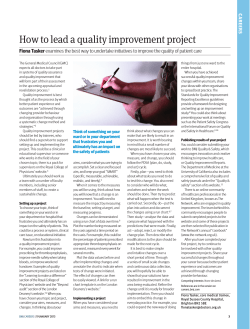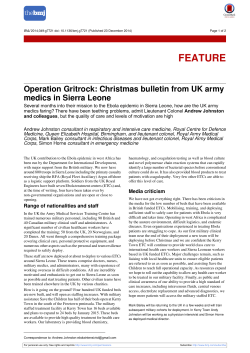
Disseminated intravascular clotting in kwashiorkor
Downloaded from http://adc.bmj.com/ on January 12, 2015 - Published by group.bmj.com Archives of Disease in Childhood, 1975, 50, 308. Disseminated intravascular clotting in kwashiorkor E. A. HASSANEIN and I. TANKOVSKY From the Children's Hospital and Haematology Unit, Tripoli, Libya Hassanein, E. A., and Tankovsky, I. (1975). Archives of Disease in Childhood, 50, 308. Disseminated intravascular clotting in kwashiorkor. The role of disseminated intravascular clotting (DIC) in the pathogenesis of the bleeding diathesis kwashiorkor was investigated in 22 patients. According to the severity of the clinical and haematological findings, two grades of DIC were observed. A severe grade of DIC was shown in 6 cases (5 fatal) presenting with thrombocytopenia, hypofibrinogenaemia, and multiple coagulation defects, and with abnormally prolonged partial thromboplastin, prothrombin, and thrombin times. A second group of 16 patients (7 fatal) showed a less severe grade of DIC manifested by thrombocytopenia, low fibrinogen level, and a clotting factor defect shown by prolonged prothrombin and thrombin times. FDPs was 8 ,ug/ml. Standard statistical methods were used and mean values were tested with Student's 't' test. The difference of the means was considered to be significant if P <0 05. Multiple coagulation defects including factors II, VII, IX, and X have been reported in kwashiorkor (Dorantes et al., 1964). Deficiency of factor V, additionally, together with thrombocytopenia in one instance, was observed in cases of severe kwashiorkor complicated by infections, particularly gastroenteritis (Hassanein and Tankovsky, 1973). Disseminated intravascular clotting (DIC) has been reported in gastroenteritis (Lufti, 1971). The possibility of DIC being of importance in severe cases of kwashiorkor is the subject of this study. Results The cases were divided into two groups, A and B, according to their severity. Detailed clinical and laboratory data for the two groups of patients are presented in Table I. Group A (6 patients): all cases showed bleeding, severe degrees of diarrhoea and infections. 5 of the 6 cases died as a result of Material and methods haemorrhage. Twenty-two patients, 10 male and 12 female, suffering The mean values for partial thromboplastin, from severe kwashiorkor, bleeding diathesis, and throm- prothrombin, and thrombin times, fibrinogen level, Their were bocytopenia investigated. ages ranged from 9 months to 3 years. They were selected out of and platelet count (Table II) were all abnormal. 132 cases of kwashiorkor admitted during the period Group B (16 patients): the severity of bleeding, of study. Dehydration of moderate or severe degree diarrhoea, and the incidence of complicating was present in the majority of cases and appropriate infections was less than in Group A. The mean fluid and electrolyte replacement given. Other measures values for prothrombin and thrombin times, included antibiotics based on stools and urine culture, fibrinogen level, and platelet count were all normal, milk feeding often by gavage, multivitamin supplements; but the mean value for partial thromboplastin time fresh blood transfusions were given to the majority of was not. Serum FDPs were estimated in the last patients when there was bleeding and severe anaemia. 10 cases admitted in this group and their serum level Haematological investigations including partial thromboplastin, prothrombin, and thrombin times, and was found to be abnormally high in 7 patients, the fibrinogen level were carried out as described by Dacie values ranging from 16 to 32 ,ug/ml. 2 of these 7 and Lewis (1968). Serum fibrin degradation products cases showed considerably prolonged thrombin (FDPs) were estimated in 10 patients using the rapid time (> 50 s); in a further 2 patients it was slightly slide screening test (Diagnostic Reagents Limited, prolonged (38-39 s), while the remaining 3 were Thame, Oxon, England). The normal value for serum normal. Received 6 September 1974. Comparison between the two groups showed significant differences in the partial thromboplastin 308 Downloaded from http://adc.bmj.com/ on January 12, 2015 - Published by group.bmj.com Disseminated intravascular clotting in kwashiorkor 309 TABLE I Clinical and laboratory data in two groups of kwashiorkor Group B (16 cases) Group A (6 cases) Clinical Diarrhoea Bleeding diathesis Severe in all cases Purpuric rash in 6 cases, intestinal haemorrhage in 3 3 cases 2 cases 2 cases Dermatosis Hepatomegaly Keratomalacia Bronchopneumonia Otitis media Skin gangrene Death 1 1 2 Severe in 3, moderate in 13 Purpuric rash in all cases cases 5 3 3 2 1 cases cases cases cases case 1 case, ear 7/16 cases case case cases face cases and scalp 5/6 Investigations Total proteins (g/100 ml) Serum potassium (mEq/l) Serum sodium (mEq/l) Blood urea (mg/100 ml) Stools culture 2 7-4 0 2 2-3 9 135-141 Negative Normal 31-4 2 2 5-4 0 128-138 30-65 Positive in 3 (Salmonella B in 2 and pathogenic Esch. coli in one) Positive in two (pathogenic Esch. coli) Normal 4 5-8 5-8 2 35-70 Positive in 2 (pathogenic Esch. coli) Urine culture Liver function tests (transaminases, flocculation tests) Haemoglobin (g/dl) TABLE II Range, mean, and standard deviation of partial thromboplastin, prothrombin, and thrombin times, fibrinogen, and platelet count in both groups of kwashiorkor, and in controls Group No. of cases thromboplastin tite (s) A 6 59 -278 119 6±37-3 32 -60 *3 44-4 ±8 8 35 --110 39 7 ±3 5 P <0 01 NS P -G001 B 16 Controls* 7 Significance A & B B&C A&B Prothrombin time (%) 1-57 20-7±10 25 22 -100 59 *3 ±23 *2 85 -110 99 3 ±8 5 P <0 01 P <0 01 P <0*01 Thrombin time (s) 29 -56 37 0 ±9 26 *2-67 37-8±-11 28 *2 -32 *6 30-0 ±12 P cO-01 P <0 01 NS Fibrinogen (mg/100 ml) 120 -180 140±28-3 120 -370 179 ±81*8 240 -320 284 3±29-6 P <0-01 P <0 01 NS (Platelt x 103) 35 - 90 62-8±23 25 95 65 5 ±28 190 - 233 224-122 P <001 P <0 01 NS NS, not significant. *Control group, 7 children, without kwashiorkor or coagulation defects, aged 1-2 years. and prothrombin times, and nonsignificant differences in the thrombin time, fibrinogen level, and platelet count. Discussion The most frequent cause of death in urban protein-calorie malnutrition, according to Hansen et al. (1968), is gastroenteritis and its consequences of dehydration and acidosis; other causes of death in hospitalized patients being infections, hypoglycaemia, hypokalaemia, and electrolyte abnormalities. This report describes another serious complication in cases of severe kwashiorkor complicated by infections, particularly those causing diarrhoea SA with debydration. The incidence of bleeding diathesis with thrombocytopenia in our study was 15%. The diagnosis of DIC in group A (severe cases) was based on the presence of thrombocytopenia, hypofibrinogenaemia, and multiple coagulation defects, i.e., prolonged partial thromboplastin, prothrombin, and thrombin times. The patients of group B (unsevere cases) were considered to show a less severe state of the DIC syndrome, with reduced platelet count, together with fibrinogen and coagulation factor defects mainly due to prothrombin deficiency. Supportive evidence was the increased level of serum FDPs in 7 out of 10 patients in this group. Clinically, the most Downloaded from http://adc.bmj.com/ on January 12, 2015 - Published by group.bmj.com 310 Hassanein and Tankovsky constant feature in all our patients was the presence of moderate or severe diarrhoea on admission, with a past history of repeated attacks of gastroenteritis. Diarrhoea is frequently met with kwashiorkor due to intestinal infection, abnormal enzymatic function, and defective absorption of the bowel (Wharton, Howells, and Phillips, 1968). Haematologically, the most constant findings in the DIC syndrome in cases of kwashiorkor were thrombocytopenia and a low fibrinogen level, while the clotting factor defects and increased serum FDPs were constant. The increase in serum FDPs found in 7 out of 10 investigated cases was not closely correlated with the antithrombin effect. This agrees with the recent findings reported by Preston et al. (1973). In the management of DIC syndrome in patients suffering from kwashiorkor, early and rapid correction of dehydration with replacement of electrolyte loss is indicated. The value of additional heparin therapy has yet to be assessed. We thank Miss Zabra Zafar for technical assistance and the Department of Statistics for statistical help. RFFERENCES Dacie, J. V., and Lewis, S. M. (1968). Practical Haematology, 4th edition, p. 74. Churchill, London. Dorantes, S., Barr6n, I., Arias, N., Vazquez, J., and Soto, R. (1964). Pathogenesis of purpura in the child with severe malnutrition. Journal of Pediatrics, 65, 438. Hansen, J. D. L., Wittmann, W., Moodie, A. D., and Fellingham, S. A. (1968). Evaluating the synergism of infection and nutrition in the field. Malntutrition, Learning and Behaviour, p. 438. Ed. by N. S. Scrimshaw and J. E. Gordon. Massachusetts Institute of Technology Press, Cambridge, Mass. Hassanein, E. A., and Tankovsky, I. (1973). Disturbances of coagulation mechanisms in protein-calorie malnutriticn. Tropical and GeoQraphical Medicine, 25, 158. Lutfi, N. S. (1971). Disseminated intravascular thrombosis in, acute gastroenteritis. XIII International Congress of Pediatrics, vol. XI, 6-8, Vienna Academy of Medicine, Vienna. Preston, F. E., Malia, R. G., Sworn, M. J., and Blackburn, E. K. (1973). Intravascular coagulation and E. coli septicaemia. J'ournal of Clinical Patholoqy, 26, 120. Wharton, B., Howells, G., and Phillips, I. (1968). Diarrhoea in kwashiorkor. British Medical Journal, 4, 608. Correspondence to Dr. E. A. Hassanein, 23 Elmina Elsharkia Street, Alexandria, Egypt. Downloaded from http://adc.bmj.com/ on January 12, 2015 - Published by group.bmj.com Disseminated intravascular clotting in kwashiorkor. E A Hassanein and I Tankovsky Arch Dis Child 1975 50: 308-310 doi: 10.1136/adc.50.4.308 Updated information and services can be found at: http://adc.bmj.com/content/50/4/308 These include: Email alerting service Receive free email alerts when new articles cite this article. Sign up in the box at the top right corner of the online article. Notes To request permissions go to: http://group.bmj.com/group/rights-licensing/permissions To order reprints go to: http://journals.bmj.com/cgi/reprintform To subscribe to BMJ go to: http://group.bmj.com/subscribe/
© Copyright 2025









